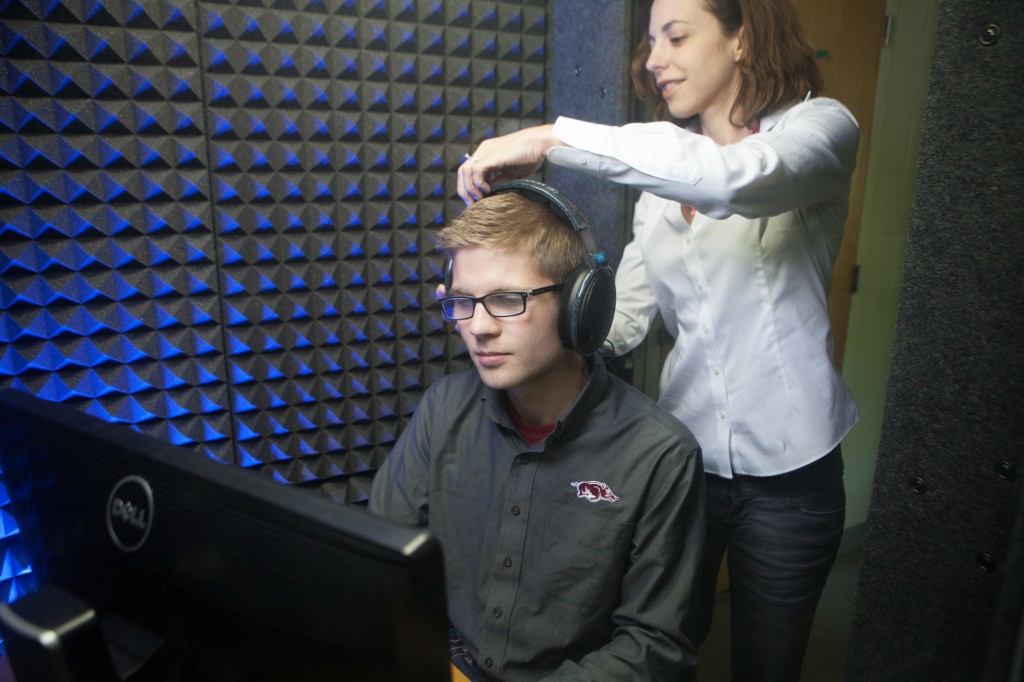Everybody’s experienced an earworm, and some of us are tormented by them regularly, but the topic has been under researched until recently. Guided by mentor Elizabeth Margulis, professor and director of the Music Cognition Lab, who recently published a book on the topic, honors psychology and music major Stephanie McCullough explored what actions are most likely to embed “Who Let the Dogs Out” in your brain. Read on for relief –– and check out Stephanie’s article, which was recently published and featured on the cover of Inquiry: The University of Arkansas Undergraduate Research Journal.
The term “earworm,” also known as Involuntary Musical Imagery (INMI), refers to the phenomenon of an uncontrollably repeating melody in one’s head. Though ubiquitous, it is comparatively under-researched in music cognition. Most existing studies have identified the defining characteristics of earworms, rather than exploring their underlying mechanisms. My study investigates the hypothesis that overt motor involvement (humming, singing, tapping) and imagined motor involvement (imagining a continuation to an interrupted melody) will induce INMI more frequently than passive music listening.
Almost all of the materials that I used were made specifically for my study. I constructed the questionnaires exactly to what I needed, I acquired the music and made cuts, and I had a friend create the monotonous activity used in the study. I learned so much about SPSS and statistics through this research, as I had never before done that part of a project. It was both empowering and enlightening.
In my experiment, the control group heard a song that ends at a normal phrase ending. The second group heard a song that stops abruptly in the middle of a phrase. The third group engaged with the music by humming, whistling, or singing along. The fourth group engaged kinetically by dancing, tapping, or nodding. All participants completed the same monotonous activity after listening to music in order to achieve a low attention state in efforts to increase earworm induction, a technique used often in previous INMI research. After the listening and visual tasks were over, participants were asked to report on any earworms that occurred during the session and answer general questions about earworm experience. In the end, conditions were nullified due to participants’ widespread compulsion to move, regardless of instruction. Results indicated that vocal and physical involvement, but not an interrupted tune, increase the frequency of triggered INMI. Earworm research has real world applications because this common phenomenon can be harnessed and applied to learning strategies. Learning more about the mechanics of INMI could help in the development of new techniques to be used with children and adults alike.

Mentor Elizabeth Margulis with honors psychology major Lane Black in the soundproof booth where Stephanie McCullough tested her subjects. Photo by Russell Cothren.
My study went mostly smoothly. After painstakingly developing the measures used and preparing my stimuli, I ran participants like crazy in Music Cognition’s creepy but homey building, Stone House South. I essentially lived in there for three weeks. I hit a bit of trouble with some inclement weather, but in the end it turned out nicely with a large number of 120 participants. Actually, 123 people participated in my study, but three were eliminated due an overwrite in data. My biggest caveat was the reaction to the activity designed to put participants in a low attention state. Of all participants, 36 reported some amount of stress or excess focus (hereafter, “dot stress”) during the dot tracking task. The purpose of this interpolation activity was to reach a low attention state, and the majority of subjects were successfully bored. Unfortunately, the wording and nature of the task caused some people to think of it as a game or view it as a test of vigilance. Those who experienced “immense” stress or “excessive” focus had far fewer earworms than those who did not during the dot task. This seems logical given that the purpose of the task was nullified by the dot stress, and thus the target attention state left unachieved by 36 participants. For this reason, INMI induction rate during the question session was additionally considered on its own, as a pair with the dot task, and for INMI experienced at all in the study.
Despite the dot stress, I was extremely pleased to have significant results. My hypothesis was supported, and I conducted research about an area of INMI that had not yet been specifically studied. I was intrigued in the topic from the start because I constantly have music in my head. I also tend to sing along or dance, so I thought it would be cool to investigate the possible effects of such engagement with music. Does my constant musical participation make me particularly vulnerable to earworms? My results seemed to proclaim so, and it was fascinating.
I have told many people that doing an honors thesis taught me more than several semesters of regular schooling. It was a project that taught me through its procedure, through my errors, through it all. It’s one thing to help with research and to do what is expected, and it’s a completely different experience to forge one’s own path in a study. Watching a vision come to reality through intense research was such an extremely gratifying experience – I loved it.
Though the independence was enlightening, none of my project would have been possible without the guidance and mentorship of my incomparable advisor, Dr. Elizabeth Margulis. Dr. Margulis was my rock through it all — she went above and beyond every call of duty without ever doing any work for me. Primarily, she amazed me with her constant and wonderful encouragement. Every time I went into her office with my perfectionist worries, feeling utterly behind, Dr. Margulis vanquished every concern of mine and always left me feeling confident, capable, and on the right track. Beyond that, her letters of recommendation helped me to earn enough money not just to conduct my research, but to travel to the International Conference of Music Perception and Cognition (ICMPC) to present my findings as well. Not every honors kid gets a rock star as a mentor, but I thankfully did. Her passion and example is one I hope to follow in my future academic (and life!) adventures.
In August, I will have the opportunity to present my research at ICMPC in Seoul, South Korea. I’m SO looking forward to another chance to travel and for the first chance to attend a conference! There are speakers relevant to my interests, and I’m incredibly delighted to spend the time with fellow lab mates and Dr. Margulis in South Korea.
After my Korean ventures (directly after — next day, in fact), I’ll be moving across the country to hold an internship in Richmond, Virginia through the Episcopal Service Corps. After a year there, I plan to get some more research experience as I work and apply to graduate programs, and ultimately I plan to pursue a Ph.D. in School Psychology.

